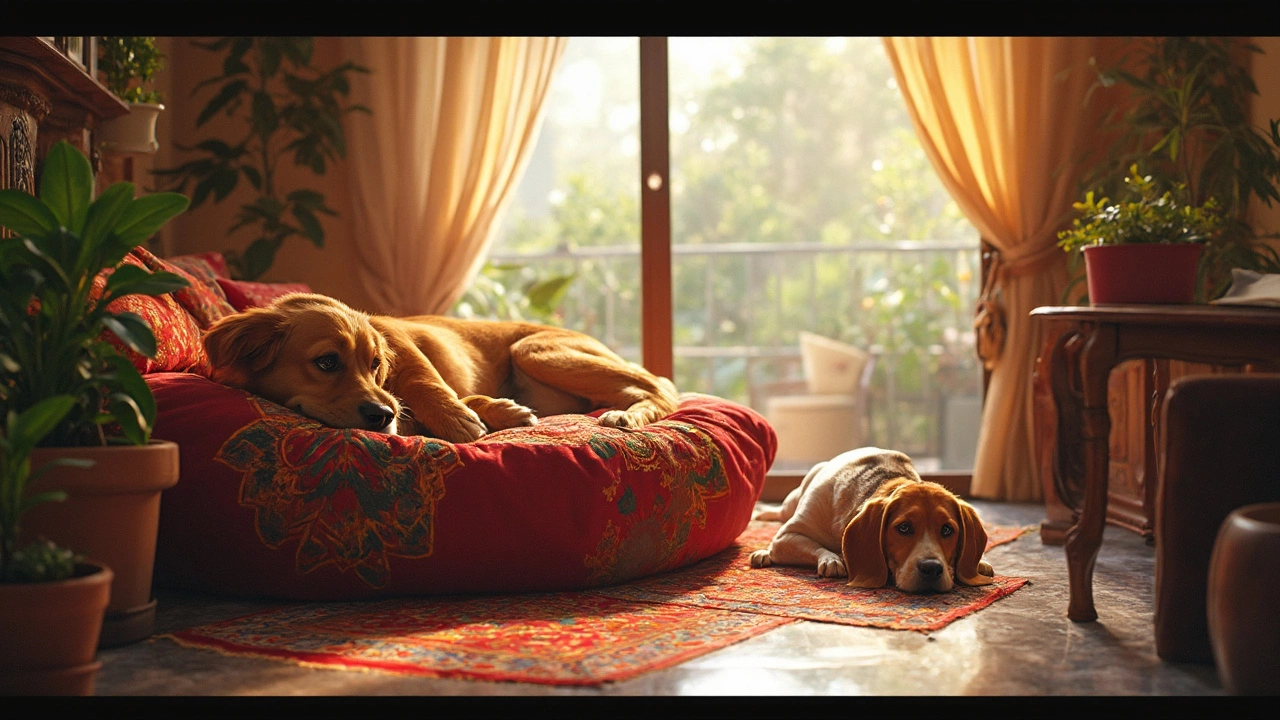
Ever drop good money on a dog bed, only to find your buddy sprawled across the tiles instead? You’re not the only one. Plenty of dog owners wonder what’s really going on in their dog’s head when it’s time to crash—does the dog bed matter, or will any old patch of floor do?
Turns out, there are legit reasons behind your dog’s sleep choices. Some dogs love beds because they’re soft, warm, and cushy on old bones. Others go straight for the floor, especially if it’s cool or if they’re feeling hot. It’s not just random—your dog’s age, breed, and even the weather can shape where they nap.
Before tossing the dog bed or trying out the fourth kind from the pet store, it helps to know what your dog is looking for. There are clear signs when your dog might need a better bed or if their floored-out spot is just their way of self-cooling. This article is all about helping you figure that out, so you feel better about your choices next time you shop—or catch your pup curled up on the tiles again.
- Why Dogs Pick One Over the Other
- What Science Says About Dog Comfort
- Breed, Age, and Sleeping Preferences
- Signs Your Dog Needs a Bed Upgrade
- Tips for Getting Your Dog to Use Their Bed
- Common Mistakes and Quick Fixes
Why Dogs Pick One Over the Other
It’s easy to assume dogs either love curling up in a bed or just don’t mind the floor, but there’s more to it. The main things driving your dog's sleeping choice are comfort, temperature, security, and sometimes plain old habit. Dogs evolved from wild animals who picked their own sleeping spots, so even your couch-loving pup still listens to some of those instincts.
Temperature’s a biggie. On hot days, you might find your dog spread out on cold tile—they’re just trying to cool off. On chilly nights, that same dog might dig into a thick bed to stay warm. Age and health also play a huge role—older dogs and dogs with joint issues almost always want something softer under them. Puppies, though, sometimes hit the floor because they just crash wherever they get tired.
Another thing is security. Some dogs want a spot that feels safe, with sides or corners to curl up against. Others just want lots of open space to stretch. If you see your dog circling or moving their bedding around, they’re doing what their ancestors did: making the spot just right.
Take a look at the most common reasons, backed up by what vets and dog behavior pros see:
- Dog beds can support joints and give better insulation for older or thin-coated dogs.
- Floors offer a stable, cool place—great for thick-furred breeds or warm weather.
- Habit: Some dogs get attached to flooring just from never using a bed as a pup.
- Cleanliness: If a bed smells or feels off, don’t be shocked if your pup ignores it.
Here’s a quick rundown comparing common dog choices and why they do it:
| Choice | Main Reason | Most Common For |
|---|---|---|
| Dog Bed | Softness, joint support, warmth | Older dogs, thin-coated breeds, cold weather |
| Hard Floor | Cooling, stability, space | Thick-coated dogs, summer, big breeds |
| Couch/Your Bed | Owner’s scent, height, comfort | Attachment-driven dogs, spoiled pups |
Watching your dog’s habits can tell you a lot. If they keep switching spots or seem restless, it might be time to tweak the setup—maybe move their bed, swap it out for something softer, or even let them chill out where they like best. The trick is figuring out what makes your dog happiest, not just what looks good in your living room.
What Science Says About Dog Comfort
There’s no shortage of research on how dogs choose where to sleep. Scientists have noticed that dogs tend to look for spots that regulate their body temperature and minimize joint pressure. For adult dogs, lying on a hard floor can put extra stress on hips and elbows, which explains why older or larger breeds are usually quick to claim a soft bed if it’s available.
One study from the University of Pennsylvania found that orthopedic beds actually help dogs with arthritis get up easier and show fewer signs of pain. On the flip side, younger or heavily coated dogs might hit the floor to keep cool, especially if the bed traps heat.
| Dog Type | Preferred Sleeping Surface | Reason |
|---|---|---|
| Puppies | Soft beds | Warmth and security |
| Adult dogs | Both | Depends on temperature and health |
| Senior dogs | Orthopedic beds | Reduces joint pain |
| Thick-coated breeds | Hard/cool floors | Prevents overheating |
Another thing: dogs like to pick sleep spots where they feel safe and can keep an eye on what’s going on. Beds placed in busy, noisy areas often get ignored, not because your pup hates them, but because the spot doesn’t feel secure. Watch your dog’s habits—does he turn in circles before lying down? That’s an old survival trick, but it also means your dog cares about comfort. If you want your dog to pick the dog bed more often, pay attention to their body language and the bed’s location.
If your dog wakes up stiff or avoids the bed completely, it might be time for a switch. Beds aren’t a one-size-fits-all deal. Science backs up that matching the bed type to your dog’s age and health can make a big difference in daily comfort, and even long-term joint health. No shame in letting your dog have a say—if he chooses floor one day and bed the next, there’s a reason behind it.
Breed, Age, and Sleeping Preferences
If you’ve got a Chihuahua and a Great Dane under the same roof, you’ll notice fast—what works for one doesn’t always cut it for the other. Breeds matter a lot when it comes to where and how dogs want to sleep. Big dogs like Labs or Mastiffs have more body weight pressing on their joints, so they often want a thick, supportive bed. Little dogs, meanwhile, love soft beds they can curl into like a donut. Huskies and Malamutes sometimes pick the bare floor because it keeps them cool, and these cold-weather breeds often have coats thick enough to make most beds feel like a furnace.
Age also changes the game. Puppies can crash anywhere—beds, couches, dirty laundry piles, you name it. But as dogs get older, things like arthritis, hip dysplasia, or plain old aches show up. Senior dogs usually hunt out softer bedding since it takes the pressure off sore spots. Here’s a quick comparison of what different ages and breeds usually look for in a nap spot:
| Dog Type | Common Preference | Notes |
|---|---|---|
| Puppy | Either (bed or floor) | Will sleep anywhere if tired enough |
| Senior dog | Soft bed | Needs joint/pain relief |
| Large breed | Thick, orthopedic bed | Joint support is a must |
| Small breed | Snuggly, plush bed | Loves to burrow or nest |
| Cold-weather breed | Cool floor (often) | Coat insulates; bed can feel too warm |
Energy matters, too. High-energy or anxious dogs sometimes sleep better in beds with bolstered sides—they like having a "den." More relaxed dogs will happily sprawl anywhere, so you might spot them tummy-up in the hallway or camped out on a rug.
There’s a big comfort boost for dog beds when your pup fits in one of those groups that benefit from extra support, especially as they age. It can even help you spot health issues: if your super active dog suddenly ditches the bed for a harder surface every night, it could mean overheating or joint pain. Keep an eye out—your pup’s nap spot can tell you a lot.

Signs Your Dog Needs a Bed Upgrade
Some dogs tough it out with a bad bed and leave you guessing. But there are red flags that it's time for a new one, and they matter for your dog's comfort and health.
Watch how your dog acts when it settles in for a nap. If they're circling and pawing for ages, it’s usually not a cute habit—it means they can't get comfortable. Restless sleep, tossing and turning, or switching spots all night? That's your dog's way of saying their current bed just isn't cutting it.
Visible wear is another clear sign. Lumpy stuffing, flattened padding, rips, or a bed that won’t hold its shape doesn’t give your dog any real support. Older dogs or big breeds especially need thick, solid padding to protect their joints. Dogs dealing with arthritis or hip dysplasia really rely on that extra cushioning.
- Choosing the floor over the bed, even when it’s cold
- Licking or scratching at sore spots or elbows (bed sores show up here)
- Dragging blankets or toys to build a softer nest elsewhere
- New smells or stains the bed won’t lose, even after washing
Check out the numbers:
| Dog Factor | How Often Bed Needs Upgrading |
|---|---|
| Puppy (still growing) | Every 6–12 months |
| Adult (healthy) | Every 1–2 years |
| Senior/large breed/joint issues | Every year, sometimes sooner |
If your dog snores, whines during sleep, or wakes up stiff, these aren’t just quirks—they can be real signs of a bad dog bed. Catching these early helps you swap out their spot before real aches set in. A quick check once every few months can save your best friend a lot of discomfort (and save you from surprise vet bills later).
Tips for Getting Your Dog to Use Their Bed
Dogs can be picky, and sometimes they just ignore that perfect-looking bed you bought. But a few tweaks can work wonders. First off, location matters a lot. If the bed is stuck in a spot far from family activity, your dog probably won’t use it. Try moving the bed close to where the family hangs out or naps—think near the couch, your workspace, or wherever your dog already drops for a snooze.
How the bed feels is another big deal. Some dogs avoid fluffy beds while others won’t lie on anything but a thick cushion. If your dog sprawls on cool floors, a thinner or gel-cooled bed may help. Older dogs with achy joints usually prefer beds with extra support or memory foam. Here’s a quick rundown based on some owner surveys:
| Dog Preference | Best Bed Type | Success Rate* (%) |
|---|---|---|
| Cuddler (likes to curl) | Bolster or donut bed | 76 |
| Sprawler | Flat mattress bed | 69 |
| Cool Seeker | Elevated or gel bed | 62 |
| Senior / Joint Pain | Orthopedic foam bed | 85 |
*Survey data pulled from a 2023 national dog owner poll.
- Use a treat or toy to lure your dog to the bed for the first week or so. When they sit or lie down, say “go to bed” and reward them right away. Repeat it a few times daily. Dogs catch on fast if there are snacks and fuss involved.
- Make the bed smell familiar. Toss in an old shirt or one of their favorite blankets. Dogs trust their own scent and yours more than new-store smells.
- Stick to a sleep routine. Try putting your dog on their bed every night before turning in, even if they hop off at first. Consistency is key.
- If you have more than one dog, give each pup their own bed. Sharing beds can cause drama, especially if one dog guards their spot.
- Keep the bed clean. Dirt, dust, or leftover crumbs can turn off even a bed-loving dog. Wash covers and vacuum the area weekly.
Remember, some dogs take time to adjust to anything new. If your pup still ignores their bed after a couple weeks, watch where they do nap and shop for a style that fits. Getting your dog bed right isn't always about the price—it's about matching your dog's true habits.
Common Mistakes and Quick Fixes
Buying a fancy dog bed doesn’t mean your pup will instantly love it. People make some easy-to-avoid mistakes when picking and placing dog beds. Here’s the good news: most problems have simple solutions.
One of the biggest mess-ups is getting a bed that's totally the wrong size. If the bed’s too small, your dog will just ditch it for the floor. And if it's way too big, some dogs don’t feel as safe or cozy. Another common snag is putting the bed in a noisy or high-traffic area—like the kitchen or right by a drafty door—where your dog can't relax.
Dogs also care about temperature way more than we think. A furry Husky might avoid the softest bed for the cool, hard tiles during summer. On the flip side, smaller or older dogs skip the floor if it gets chilly. Don’t forget some pups just hate certain textures or smells—washing the bed too little (or too much with strong detergent) can make them steer clear of it.
“Dog preferences for sleeping spots often depend on comfort, temperature, and location. Sometimes, it just takes a bit of tweaking to get a dog to love their bed.” — Dr. Paula Simons, DVM, Vet Content Specialist at K9 of Mine
The good news: most of these issues are easy to fix if you know what to look for. Here’s a cheat sheet to avoid the most common blunders:
- Size matters: Measure your dog from nose to tail and pick a bed that’s just the right fit—enough room to stretch, but small enough to curl up and feel secure.
- Location counts: Put the bed in a quiet spot away from drafts, direct sunlight, and heavy foot traffic. Dogs like to feel safe and part of the family but not stuck in the middle of chaos.
- Check the filling: Orthopedic foam is a lifesaver for seniors, while fluffy fillings are great for dogs who like to burrow. Avoid anything that clumps up after washing.
- Watch the wash: Clean beds regularly, but skip harsh chemicals or strong scents. Choose fragrance-free detergents and rinse well.
- Watch for allergies: If you notice your dog sneezing, scratching, or avoiding the bed, it might have to do with the fabric or what you’re using to clean it.
Still not sure? Check the numbers—the American Pet Products Association reports that 27% of dog owners have tried three or more beds to find one their dog likes. You’re not alone if you’re troubleshooting!
| Common Mistake | Quick Fix |
|---|---|
| Too small or too large bed | Measure your dog and match the bed |
| Placed in noisy area | Move bed to calm, cozy zone |
| Wrong temperature | Choose cooling mats or thick padding as needed |
| Unliked material | Test a few covers or fabrics |
| Strong detergent scent | Use mild, scent-free cleaners |
If your dog ignores the bed, rotate through locations or lay an old T-shirt with your scent on it up top. Sometimes all it takes is the right combo of location, comfort, and familiarity. Dogs really do tell us what they like—you just have to listen.


